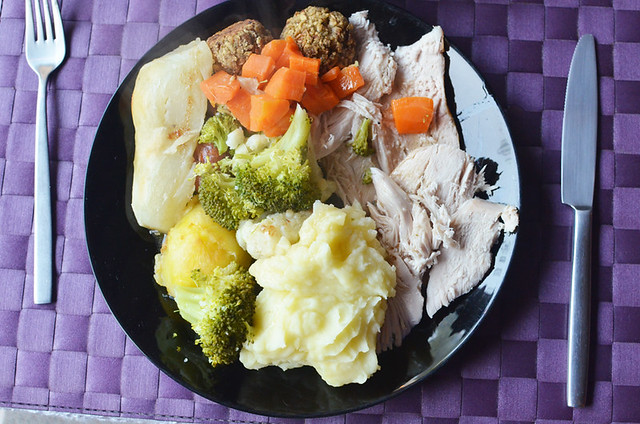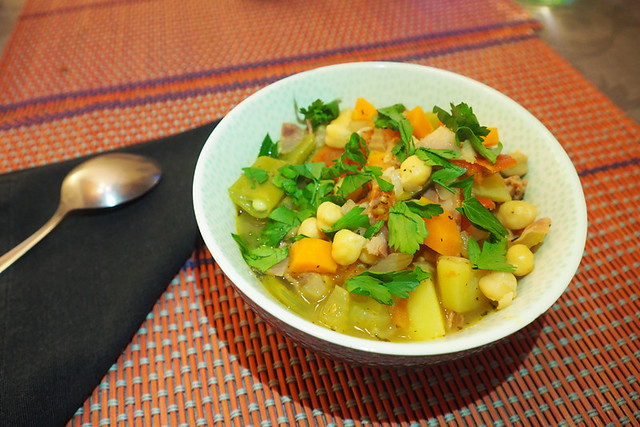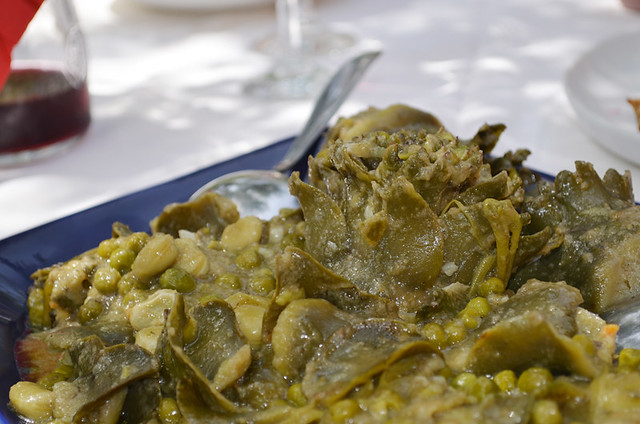Where’s the veg? I saw the phrase ‘meat and two veg’ the other day, coincidentally as I was uploading photos of our lockdown meals to Facebook, which were definitely not of the meat and two veg variety. For some reason the phrase jumped out at me, and for the first time I realised what a curious thing it is.

A regular moan by British contributors to Tripadvisor’s restaurant reviews concerns vegetables in restaurants abroad, or more accurately a lack of. Countries outside of Britain just don’t seem to cut the mustard when it comes to delivering that ‘two veg’ quota.
Having once been pescatarians for many years, we kicked the meat and two veg habit a long time ago. Since we became carnivores again it does make an appearance on the dining table, but only at Christmas and Easter when there are more than two vegetables anyway. But mulling over how our approach to eating has changed over the years got me thinking about the whole concept of meat and two veg, and why so many British travellers seemed to be disappointed by the vegetable situation when they travel to other European countries.
“There was a lack of vegetables available as side orders…”
“Excellent place but a severe lack of vegetables…”
“The service was excellent but there was a lack of greens…”
“Some restaurants seem to have an aversion to vegetables…”

You can find any number of comments like these in Tripadvisor’s restaurant reviews. Someone who didn’t know any better might think only the British were keen on eating vegetables, which is obviously nonsense. The Mediterranean diet is generally considered one of the healthiest going. Pyramid diagrams illustrating what constitutes a Mediterranean diet show the foundation base (what’s consumed most) consists of whole grains, fruits, vegetables, beans, herbs, spices, nuts and healthy fats such as olive oil. Next up is fish and seafood (usually eaten at least twice a week). Then it’s dairy foods (yogurt and traditional cheeses), eggs and poultry. At the tiny top of the pyramid are red meat and sweets. A variation of this diet is adhered to by people in coastal parts of Albania, Algeria, Bosnia and Herzegovina, Croatia, Cyprus, Egypt, France, Greece, Israel, Italy, Lebanon, Libya, Malta, Monaco, Montenegro, Morocco, Slovenia, Spain, Syria, Tunisia, and Turkey. You can throw Portugal into this mix as well.

Many of these are countries where eating a generous and ‘healthy’ amount of vegetables is a fundamental part of the diet, and yet some are also European countries whose restaurants often earn criticism from British travellers for not serving enough vegetables. So why the disconnect?
The whole concept of meat and two veg could be the culprit.
There are plenty of delectable vegetable dishes around Europe, but they’re not generally presented in the way we’re conditioned to recognise them. I grew up with two types of steamed vegetables being plonked on my plate; the dullest part of any meal for me. Do a quick Google image search for ‘meat and two veg’ and just see what you get. If you’re British it will be painfully familiar – carrots and peas, carrots and sprouts, carrots and broccoli. The way ‘two veg’ are generally presented on a plate in Britain is the culinary equivalent of being shown around a house with magnolia walls. There’s no imagination involved and the appearance doesn’t exactly get the taste-buds stirring.

In Spain those vegetables might be in the form of a rainbow row of roasted peppers sprinkled with herbs. In Greece it could be in the form of mezes involving stuffed vine leaves and fried aubergines. In Italy they might appear as courgette flowers or wild mushrooms. There are oodles of interesting and tasty vegetables side dishes to be tried on our travels. Additionally, often vegetables are incorporated into dishes rather than as an aside, so might remain invisible to anyone who sticks to ordering just slabs of meat when they visit countries with a Mediterranean style of eating. The meals we cook at home rarely involve meat and two veg, but they regularly include more than two vegetables. A favourite recipe we cook a lot, Middle eastern chickpea stew, has seven.

As a nation we’re out of step when it comes to how meat and vegetables are presented. There’s a very good reason for that. Meat and two veg is a uniquely British tradition, one which isn’t even that old. It was introduced during the post-Second World War period, the ‘two veg’ being there to supplement the meagre serving of meat which was initially rationed and then, for a while afterwards, still relatively scarce. My parent’s generation was the first for which meat and two veg was the norm, and they, in turn, made it the accepted way of serving meat for Baby Boomers and Generation X – usually those now writing ‘disappointed from Croydon’ restaurant reviews on Tripadvisor.
What that boils down to is meat and two veg is a concept borne purely out of restrictions rather than as a good way of cooking and presenting vegetables. There’s absolutely no reason for us Brits to continue with it, except as a habit.




Be the first to comment